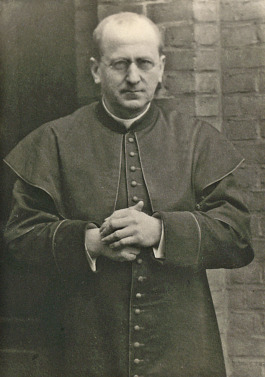Bernhard Lichtenberg facts for kids
Quick facts for kids BlessedBernhard Lichtenberg |
|
|---|---|

Fr. Bernhard Lichtenberg
|
|
| Priest and martyr | |
| Born | 3 December 1875 Ohlau, Prussian Silesia, Kingdom of Prussia, German Empire |
| Died | 5 November 1943 (aged 67) While being transported from Berlin to Dachau concentration camp, Germany |
| Venerated in | Roman Catholic Church (Germany) |
| Beatified | 23 June 1996, Germany, by Pope John Paul II |
| Major shrine | St. Hedwig's Cathedral, Berlin, Germany |
Bernhard Lichtenberg (born December 3, 1875 – died November 5, 1943) was a brave German Catholic priest. He is remembered for speaking out against the persecution and deportation of Jewish people during the time of Adolf Hitler and the Holocaust. Even though he was jailed, he continued to stand up for what was right. He died while being taken to a concentration camp.
The Catholic Church recognized him as a "Blessed" person in 1996. In 2004, he was also honored as "Righteous Among the Nations" by Yad Vashem. This special title is given to non-Jewish people who risked their lives to save Jews during the Holocaust.
Contents
Early Life and Education
Bernhard Lichtenberg was born in a town called Ohlau (now Oława) in what was then Prussian Silesia. This area is now part of Poland. He was the second of five children in his family.
He studied to become a priest in Innsbruck, Austria-Hungary, and also in Breslau (now Wrocław). He officially became a priest in 1899.
His Work as a Priest
Starting His Ministry
In 1900, Lichtenberg began his work as a priest in Berlin, Germany. He served as a pastor in Charlottenburg. During World War I, he also worked as a military chaplain, helping soldiers.
From 1913 to 1930, he was a minister at the Sacred Heart church in Charlottenburg. In 1932, the Bishop of Berlin made him a "canon" of St. Hedwig's Cathedral. This meant he had an important role in the church leadership.
Standing Up for Others
Bernhard Lichtenberg was not afraid to speak his mind. In 1930, he encouraged Catholics to watch a movie called All Quiet on the Western Front. This film was against war, and the Nazi government's newspaper attacked him for it. In 1933, the secret police, known as the Gestapo, searched his home for the first time.
He was also active in a political group called the Centre Party. In 1935, he even went to see Hermann Göring, a powerful Nazi leader, to protest against the cruel treatment of people in the Esterwegen concentration camp.
In 1938, Lichtenberg became the "provost" of St. Hedwig's Cathedral. He was put in charge of a special office that helped many Catholics of Jewish background leave Germany. After Kristallnacht (a terrible night in 1938 when Nazis attacked Jewish homes and synagogues), Lichtenberg bravely spoke out. He said in his church, "The synagogue outside is burning, and that is also a house of God!"
Until his arrest in October 1941, Father Lichtenberg prayed publicly every day for the Jewish people who were being persecuted. The Bishop of Berlin later asked him to help the Jewish community in the city.
He also personally protested to Nazi officials about the killing of sick and mentally ill people. The Nazis first ignored him, but Father Lichtenberg kept speaking out, even though he was warned that he could be arrested.
Arrest and Imprisonment
Bernhard Lichtenberg was arrested on October 23, 1941. He was sentenced to two years in prison because he spoke out against the government. While in prison, he even asked if he could go with Jewish people being sent to the East, so he could comfort them.
Because he refused to change his views, the Gestapo decided to send him to the Dachau concentration camp in 1943. Sadly, he became very ill with pneumonia during the journey and died in a hospital in Hof, Bavaria.
Remembrance
On June 23, 1996, Pope John Paul II declared Bernhard Lichtenberg a "Blessed" martyr. A large ceremony was held in the Olympic stadium in Berlin. November 5, the day he died, is now a special day to remember him in the Catholic Church.
Bernhard Lichtenberg's tomb is in the crypt of St. Hedwig's Cathedral in Berlin. After the war, the building where the archbishop of Berlin works was named the Bernhard Lichtenberg House. There is also a memorial plaque at the former Esterwegen concentration camp to honor him.
In the town of Hof, Bavaria, a square in front of St. Mary's church was named Bernhard-Lichtenberg-Platz in 2013. A new church center named after him was also built there in 2016/17.
On July 7, 2004, Yad Vashem officially recognized Bernhard Lichtenberg as a Righteous Among the Nations for his heroic actions.
See also
 In Spanish: Bernardo Lichtenberg para niños
In Spanish: Bernardo Lichtenberg para niños
- Catholic resistance to Nazi Germany
- Rescue of Jews by Catholics during the Holocaust

